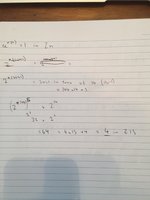(Questions attached) my answer for 3a is:
Since p is a prime number, the only possible values of are 1 and p. The only way to have is if n is a multiple of p. There is only 1 multiple less than p. Therefore, the other p-1 numbers are all relatively prime to p. Hence, if and p is prime: φ(p)=p−1
I'm familiar with Fermat's theorem, although I'm a bit confused with how it translates in 3b - could I please have help with this? Is what I've put below on the right track?

Since p is a prime number, the only possible values of are 1 and p. The only way to have is if n is a multiple of p. There is only 1 multiple less than p. Therefore, the other p-1 numbers are all relatively prime to p. Hence, if and p is prime: φ(p)=p−1
I'm familiar with Fermat's theorem, although I'm a bit confused with how it translates in 3b - could I please have help with this? Is what I've put below on the right track?


